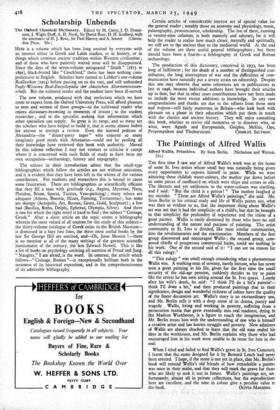Scholarship Unbends
HERE is a volume which has been long awaited by everyone with an interest either in Greek and Latin studies, or in history, or in things which continue ancient tradition within Western civilisation ; and of those who have patiently waited none will be disappointed. Since the days of the seven-volume antiquated " Smith " (1873 to 1891), black-bound like " Crockford," there has been nothing com- prehensive in English. Scholars have turned to Liibker's one-volume Reallexikon (1914) before passing on to the vast, and still unfinished Pauly-Wissowa Real-Encyclopiidie der classischen Aherrumswissen- schaf t. But the cultured reader and the student have been ill-served.
The new volume, produced with that perfection which we have come to expect from the Oxford University Press, will afford pleasure to men and women of three groups—to the cultivated reader who enjoys dictionary-browsing in moments of leisure ; to the student researcher ; and to the specialist seeking that information which other specialists can supply. So great is its range, and so many are the scholars who have helped to build it, that it seems almost hubris for anyone to attempt a review. Even the learned pedants of Alexandria—the " dinner-party sages " who enjoyed so many imaginary good meals with Athenaeus—could not by pooling all their knowledge have reviewed this book with authority. Moved by this solemn reflection I may not venture to criticise it except where it is concerned with such fields of study as have been my own occupation—archaeology, history and topography.
The editors in their introduction admit that the small-type bibliographies which follow the articles are not without omissions, and it is evident that they have been left to the whims of the various contributors. For students and researchers this is bound to cause some frustration. There are bibliographies so scientifically efficient that they fill a man with gratitude (e.g., Aegina, Mycenae, Nero, Pheidon, Rome, Sparta, Tacitus, Vase-painting) ; many others are adequate (Athens, Boeotia, Mines, Painting, Terracottas) ; but some are skimpy (Acropolis, Art, Bronze, Gems, Gold, Sculpture) ; a few bad (Basilica, Baths, Delphi, Ephesus, Olympia, Silver). And there is one for which the right word is hard to find ; the subject " Coinage, Greek." After a short article on the topic comes a bibliography wherein the most valued of all sources for the study of this subject— the thirty-volume catalogue of Greek coins in the British Museum— is dismissed in a bare two lines, the three most useful books by the late Sir George Hill are omitted, and—Oh, Juno Moneta ! —there is no mention at all of the many writings of the greatest scientific numismatist of the century, the late Edward Newell. This is like a list of books on psychology omitting all mention of Freud and Jung. " Naughty," I am afraid, is the word. In contrast, the article which follows—" Coinage, Roman "—is exceptionally brilliant both in the terseness of its historical exposition, and in the comprehensiveness of its admirable bibliography. Certain articles of considerable interest are of special value for the general reader ; notably those on anatomy and physiology, music, palaeography, pronunciation, scholarship. The last of these, running to twenty-nine columns, is both masterly and salutary, for it will help the reader to realise how much closer, mentally and spiritually, we still are to the ancient than to the mediaeval world. At the end of the volume are three useful general bibliographies ; but there should have been a fourth—a bibliography of Greek and Roman archaeology.
The production of this dictionary, conceived in 1933, has been long of fulfilment ; for the death of a number of distinguished con- tributors, the long interruption of war and the difficulties of com- munication have naturally put a severe strain on editorship: Despite this one may observe that some references are to publications as late as 1946, because individual authors have brought their articles up to date, but that in other cases contributions have not been made to include the most recent additions to knowledge. In any case congratulations and thanks are due to the editors from those men and women—still fairly numerous in Britain—who look back with pleasure on a phase in their education which put them in touch with the classics and ancient history. They will enjoy consulting this book, whether to revive old memories or to discover who, or what, were Agiads and Eurypontids, Gnipho, Mefitis, Ops,
Propemptikon and Thubursicum. CHARLES SELTMAN.














































 Previous page
Previous page